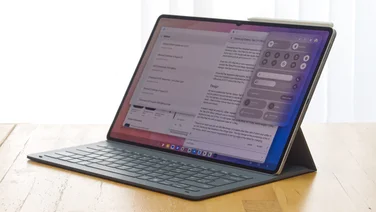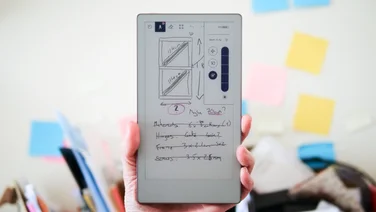To help us provide you with free impartial advice, we may earn a commission if you buy through links on our site. Learn more

- High-resolution scans
- Straightforward wiping process
- Well-designed accompanying app
- Prone to wear and tear
- Only compatible with Pilot's Frixion pens
Nothing – repeat nothing – can replace the immediate tactile satisfaction of scribbling notes with pen and paper. Not Apple Pencil, not the Galaxy Note, nothing that involves a stylus and a slab of glass.
Rocketbook Wave doesn’t attempt to replace pen and paper – it is pen and paper. However, it attempts to bring some of the benefits of digital writing systems by letting you scan your handwritten notes with a smartphone and then wipe the book clean by giving it a quick spin in the microwave. Is it the proverbial best of both worlds?
Rocketbook Wave review: Performance
Agonisingly, not quite. As someone who’s spent years and way too much disposable income trying to bring some order to my handwritten notes, the Rocketbook Wave looked (if you’ll forgive the pun) good on paper. However, a couple of weeks spent jotting notes on its pages reveals flaws that prevent it from earning my unqualified endorsement.
READ NEXT: Samsung Galaxy Note 9 review
The first sticking point is the pens you have to use. The Rocketbook system is only compatible with Pilot’s Frixion pens – one comes free with the book. Jot down a phone number in your book with a nearby Biro when you’re on a phone call, and that’s your page ruined – it can’t be erased. That said, the Frixion range is widely available and not hideously expensive (£8.99 for a pack of five rollerballs on Amazon); you just have to remember to keep pen and pad close by.
The pad itself isn’t lined but marked with a feint grid of squares that aid the scanning process. That makes jotting notes slightly more awkward that it needs be. I’m constantly squinting to check I’m on the line, which is something that doesn’t even enter my consciousness with regular notepads.
The scan is performed with the accompanying smartphone app (iOS and Android), which is immaculately designed. Rocketbook is also integrated with a number of well-known services, including Dropbox, OneNote, Google Drive, Evernote and email. You simply tick a box at the bottom of each page to tell it which service or services you want the scanned notes delivered to and the rest is done seamlessly.
Files are delivered to their destination as PDFs, but forget about anything like OCR – you’ll have to rely on the destination app (such as OneNote) to convert handwriting into searchable text, which has always been imperfect in my experience.
The scans are high-resolution: up to 4,032 x 3,024 on my test Galaxy S7, but the default resolution is 3,264 x 1,836. That’s perfectly sufficient to make handwriting legible or retain the detail of hand-drawn diagrams. Scans are straightened perfectly, too. However, the grid of squares on the page is partially visible on the scanned results and some of my scans were marred by blue marks, which I suspect is the result of the scanned page getting damp at some point. These are notebooks you need to take good care of.
Rocketbook Wave review: How does it work?
Each 80-page notebook can be re-used up to five times. The wiping process is straightforward: pop the notebook on your microwave oven’s rotating plate, place a mug of water on top of the notebook to prevent the pages from charring, and blast the book at full power until the blue logo on the front of the pad disappears. Then flip the notebook over and repeat. The whole process takes less time than cooking a ready meal.

Are the pages wiped absolutely clean? Not quite. If you look closely, you can still see the underlying trace of what was written on the pages previously. However, some of that’s down to indentations – I press quite firmly when writing, so I’m scratching the page as I write. And, of course, the more you re-use the books, the worse the show-through from previous etchings becomes. It’s by no means a show-stopper, but it makes it even harder to see where those grid lines are when you’re writing.
READ NEXT: Wacom Bamboo Spark review
Rocketbook Wave review: Price
Then we come inevitably to the price. The 15.2cm x 22.6cm “Executive” notebook costs £26, which makes even Moleskine notebooks look like pound-shop items by comparison. If you got all five uses out of your Rocketbook Wave, that price effectively tumbles to around a fiver a book, but would you get all five uses?
Even after only a fortnight in my work bag, the Rocketbook Wave is starting to look tatty. It’s just a hard bound paper notebook, after all. And with the potential to ruin pages with coffee stains, smudges or absentmindedly jotting notes with the wrong type of pen, I think the chances of getting all the way through five full re-uses of the book are slim.
You have to admire the ingenuity and design effort that’s gone into the Rocketbook Wave. If you absolutely refuse to be parted from pen and paper and want some of the benefits of digitisation, it’s worth serious consideration.







